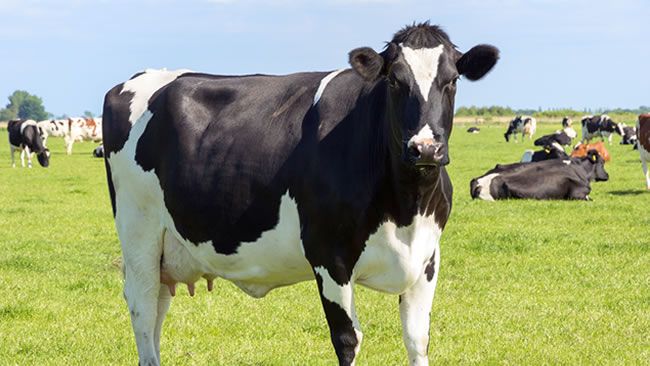HPAI in Cows
A strain of highly pathogenic avian influenza (HPAI) has been silently spreading in U.S. cattle for months. Preliminary genomic analysis suggests that the outbreak likely began when the virus jumped from an infected bird into a cow, probably around late December or early January. This marks the first time that these bird flu viruses have been found in cattle. The Centers for Disease Control and Prevention (CDC) confirmed one human infection with HPAI A (H5N1) that had exposure to dairy cattle in Texas presumed to be infected with the virus. While such exposure is thought to be rare, this instance represents the first likely case of mammal-to-human transmission. Since 2022, the United States Department of Agriculture (USDA) Animal and Plant Health Inspection Service (APHIS) has reported HPAI A (H5N1) virus detections in more than 200 mammals. Although rare, mammals can be infected with highly pathogenic avian influenza when they consume infected birds, poultry, or other animals, or if they are exposed to virus-contaminated environments. While the risk of spread from mammal to mammal is considered low, the wide geographic distribution of HPAI A (H5N1) viruses in wild birds, poultry, and some other mammals, including cows, could create additional opportunities for human exposure. Therefore, people with job-related or recreational exposure to infected birds or animals, including cows, are at greater risk of contracting HPAI A (H5N1) virus
What is HPAI?
Highly Pathogenic Avian Influenza (HPAI), commonly known as bird flu, is a severe and contagious viral disease that primarily affects birds, especially poultry. It is caused by influenza A viruses, specifically subtypes H5 and H7.
Pathogenicity:
Highly pathogenic means that the virus causes severe illness and high mortality rates in infected birds.
HPAI viruses can rapidly spread within poultry flocks and cause significant economic losses in the poultry industry.
Transmission:
Birds can become infected through direct contact with infected birds, contaminated feed, water, or surfaces.
Wild birds, especially waterfowl, are natural reservoirs for avian influenza viruses and can spread them to domestic poultry.
Symptoms:
Infected birds may exhibit symptoms such as sudden death, respiratory distress, swelling of the head, neck, and eyes, and a drop in egg production.
HPAI can also infect mammals, including humans, although this is rare.
Human Health Risk:
While most human cases are associated with exposure to infected birds, there have been instances of limited human-to-human transmission.
Proper precautions are essential for individuals working with infected birds or handling contaminated materials.
Control Measures:
Surveillance, culling of infected birds, and strict biosecurity measures are crucial to controlling outbreaks.
Vaccination of poultry can also be used in some cases.
How to run testing of HPAI?
Like the other virus, Highly Pathogenic Avian Influenza (HPAI) testing involves several methods to detect the presence of the virus in birds. These approaches include,
Virological Tests:
Virus Isolation: This method involves collecting swabs or tissue samples from infected birds and attempting to grow the virus in cell cultures. If the virus replicates, it confirms the presence of HPAI.
PCR (Polymerase Chain Reaction): PCR amplifies specific viral genetic material (RNA) to detect the virus. It is highly sensitive and widely used for avian influenza diagnosis.
Real-Time PCR (qPCR): Similar to PCR, but it provides real-time results during the amplification process. qPCR is now regarded as the gold standard for virus quick testing, such as the Avian Influenza Virus H5N1 Real-time PCR Kit, Avian Influenza Virus H7N9 Real-time PCR Kit. These qPCR tests detects RNA of the virus, thus they can also be used in animals other than avians, such as cows.
Serological Tests:
Hemagglutination Inhibition (HI) Assay: This test detects antibodies produced by the bird’s immune system in response to HPAI infection. It helps identify past exposure.
ELISA (Enzyme-Linked Immunosorbent Assay): ELISA detects specific antibodies against avian influenza viruses. It can differentiate between vaccinated and infected birds. For example, the Ringbio Avian Influenza Multispecies Antibody Competitive ELISA Kit, and the Ringbio Avian Influenza H5 Antibody ELISA Kit, AIV H5 Ab ELISA Kit, Avian Influenza H7 Antibody ELISA Kit, AIV H7 Ab ELISA Kit. To detect influenza antibodies in cows, you will need to use the Avian Influenza Multispecies Antibody Competitive ELISA Kit.
Rapid Antigen Detection Tests:
These tests use specific antibodies to detect viral proteins (antigens) directly from swab samples. They provide quick results but may be less sensitive than PCR. The Ringbio Avian Influenza H5 Antigen AIV H5 Ag Rapid Test Kit can be used for quick detection of H5 type of AIV, including the H5N1 strains, while the Ringbio Avian Influenza H7 Antigen AIV H7 Ag Rapid Test Kit can be used to detect H7 type of AIV, such as H7N9. These Influenza Antigen Rapid tests detects nucleoprotein of the virus, thus they can also be used in animals other than avians, such as cows.
More information on Ringbio avian rapid tests can be found here. If you need any further info, you can also contact Ringbio team directly by email [email protected]




